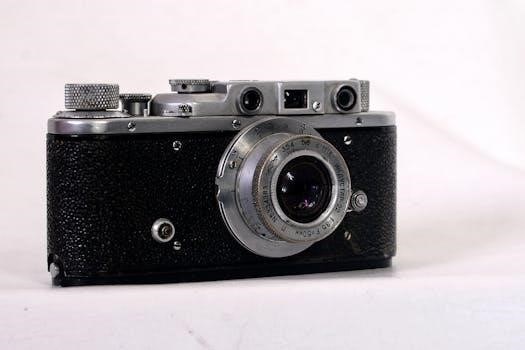texecom premier elite user manual
Category : United Kingdom
Texecom Premier Elite User Manual⁚ An Overview
This manual provides a comprehensive guide to the Texecom Premier Elite alarm system. It covers essential aspects such as system operation‚ user access‚ and troubleshooting. This document will aid both new and experienced users in navigating the system’s features. It also includes details on wireless device integration.
The Texecom Premier Elite series represents a sophisticated range of security solutions designed for both residential and commercial properties. These systems are known for their robust performance‚ flexibility‚ and scalability‚ allowing users to tailor the security setup to their specific needs. The Premier Elite panels support a variety of wired and wireless devices‚ including detectors and keypads‚ providing comprehensive protection. With advanced features like remote monitoring and event logging‚ users can stay informed about the system’s status; The Premier Elite systems are designed to be user-friendly‚ with intuitive interfaces for easy operation‚ making them a popular choice for security. They also offer expandability allowing the system to grow as needed. The system also has capabilities for multi-zone management. The Premier Elite series offers a reliable way to secure premises. The integration with WebWay alarm monitoring system increases security and reliability. The system is designed to be robust and reliable‚ offering comprehensive security solutions for various needs.
Understanding Keypad Operation
The Texecom Premier Elite system relies heavily on its keypad for user interaction. Keypads come in various models‚ such as the LCD keypad‚ each offering different features and layouts. The keypads provide a user interface for arming‚ disarming‚ and managing the security system. Understanding the basic functions of the keypad is crucial for effective operation. Keypads are the primary point of control and display system status and alerts. The interface typically includes a number of buttons for navigation‚ arming modes‚ and quick access to other functions. LCD keypads display detailed information‚ such as zone status and system events. Proper use of the keypad is crucial to manage the alarm system. The keypads are designed to be user-friendly but require some understanding of their layout. Users need to familiarize themselves with the keypad’s functionality to control the system effectively. Keypads support multiple user codes. The system may include multiple keypads to provide access from different locations. Keypad operation is vital for effective system management.
LCD Keypad Features
The LCD keypad for the Texecom Premier Elite system is a sophisticated interface offering numerous features. Its large screen displays detailed system information‚ such as zone status‚ current time‚ and date. The LCD keypad provides text-based prompts and menus for easier navigation compared to basic LED keypads. It also displays system alerts and alarms‚ ensuring users are always aware of the system’s status. The keypad features a backlit display‚ improving visibility in low-light conditions. This large screen allows for better readability‚ which is especially useful for older users. The LCD keypad also has a built-in speaker that provides audible feedback for key presses and system events. The keypad’s buttons are clearly labeled for easy operation. This user-friendly design simplifies interactions with the alarm system. The LCD keypad allows for easy management of user codes. It also allows system testing and quick access to the event log. The interface is designed to be intuitive‚ minimizing the learning curve for new users. The keypad is more detailed compared to simpler keypads. The LCD screen provides a clear visual representation of system status. The LCD keypad is an essential part of the Texecom Premier Elite.

Navigating the Menu
The menu system on the Texecom Premier Elite LCD keypad is designed for intuitive navigation. The main menu is accessed using dedicated buttons on the keypad‚ typically labeled “Menu” or “OK.” Once in the menu‚ users can navigate through the different options using arrow keys. The menu is organized hierarchically‚ with main categories and subcategories. This structure makes it easier to find specific settings or functions. Selecting a menu item is usually done by pressing the “OK” or “Enter” button. The system provides clear prompts and instructions on the LCD screen. This helps guide the user through each step. Users can move back to the previous menu using the “Escape” or “Back” button. The menus allow for configuring various system parameters‚ like user codes‚ zone settings‚ and system tests. The menu navigation is consistent‚ ensuring a smooth user experience. The menu system is well organized‚ making it simple to find the necessary options. Users can use the menu to view the event log‚ access system status reports and program user access rights. Navigating through the menus can be done even by first-time users. The intuitive design of the menu minimizes the learning curve. The clear text on the screen makes it easy to understand. The keypad’s menu is a central point for managing various aspects of the alarm system. The menu can be used to test sensors and other devices.
Arming and Disarming the System
Arming and disarming the Texecom Premier Elite system is a straightforward process‚ designed for ease of use. The primary method involves using the keypad‚ where a user enters their unique access code. This code must be correctly entered for the system to either arm or disarm. Arming the system typically activates all sensors‚ providing full perimeter protection. There are usually different arming modes available‚ such as full and part arming. The keypad will indicate the current arming status with a clear display. When disarming‚ the same access code is used. Upon entering the correct code‚ the system will deactivate‚ and the alarm will not trigger. The system may also support arming and disarming via key fobs or mobile apps‚ depending on the configuration. These alternative methods provide convenience and flexibility for users. It’s crucial to understand the different arming modes to ensure the correct level of protection is activated. Incorrect codes will result in the system remaining either disarmed or triggering an alarm. The system typically provides visual and audible feedback to confirm arming and disarming actions. This feedback helps users understand the system’s current status at all times. The arming and disarming process is a fundamental part of system operation. Regular practice will ensure smooth and efficient system management; The user manual should be consulted for specific details and configurations. Correct operation of arming and disarming is critical for security.
Full Arming Procedures
Full arming of the Texecom Premier Elite system activates all available sensors‚ providing maximum security coverage. To initiate full arming‚ begin by ensuring all doors and windows are closed. Then‚ approach the keypad and enter your designated user code. Upon entering the correct code‚ the system will typically emit a confirmation tone or display a message indicating that arming is in progress. This process activates all perimeter and internal sensors. Once fully armed‚ the system will monitor all designated zones for any intrusion attempts. The keypad may also display a countdown timer‚ allowing users time to exit the premises before the system becomes fully active. Failure to exit within this time may trigger the alarm. The full arming mode is ideal for when the property is unoccupied. It ensures comprehensive protection of the entire premises. It is vital that all sensors are functioning correctly to avoid false alarms. The system may also allow you to arm using a key fob or a mobile app. After fully arming‚ the system will remain active until disarmed. To disarm‚ the user code must be entered correctly at the keypad. Understanding this procedure is vital for ensuring full protection. Full arming is a core function of the alarm system. Regular practice of arming and disarming is recommended for familiarity. It is essential to consult your manual for specific settings and configurations.
Part Arming Options
Part arming‚ also known as ‘stay’ arming‚ allows users to secure specific zones while leaving others inactive; This is particularly useful when occupants are present in the building but require perimeter protection. The Texecom Premier Elite system offers flexible part arming configurations to suit various needs. To initiate part arming‚ you will typically need to use a specific user code or function key. The keypad will then present options to select which zones will be armed. For example‚ perimeter zones such as doors and windows might be armed‚ while internal zones are disarmed to allow free movement inside. The system will indicate which zones are active and which are not. Some systems may require you to configure part arming settings in advance. This could include designating certain zones for day or night mode. Part arming provides a balance between security and convenience. It can be modified at any time to accommodate different situations. Incorrectly configured part arming could result in unintentional alarm activation. Understanding how to correctly utilize part arming is crucial for effective home security. The system may provide different types of part arming modes‚ such as sleep mode. It is important to consult the manual for details on setting up and utilizing these modes. The use of this function should be practiced to ensure familiarity. This feature is helpful for maintaining a sense of security whilst still being present at the property. It enhances the flexibility of the security system. It is vital that all users are familiar with its operation. The correct process should be followed every time.
User Codes and Access Management
The Texecom Premier Elite system employs user codes to control access and system operation. These codes are essential for arming‚ disarming‚ and performing other functions. Effective management of user codes is vital for maintaining security. Each user can be assigned a unique code‚ which allows for tracking of system activity and restricting access. The system typically has a master code‚ used for administrative functions such as adding or deleting user codes. It is important to keep the master code secure and limit access to authorized personnel. User codes can be customized with different permission levels. For example‚ some users might only be able to arm/disarm the system‚ while others might have access to more advanced functions. Regular review of user codes is recommended to remove inactive or unauthorized users. The keypad interface is used to manage user codes; The process of adding a new user code involves entering the master code‚ selecting the user number‚ and entering the new code. Deleting a user code is a similar process. It requires the master code and selection of the user to be removed. Good practice includes regular changing of user codes‚ especially if security breaches are suspected. This helps in preventing unauthorized access to the system. The system provides a log of all activity‚ including user code usage. This feature is useful for audit purposes. Understanding how to manage user codes is crucial for maintaining system security. User code management is a critical component of the security system; It should be reviewed on a regular basis. This guarantees that only those with the necessary authority can make changes to the system. This function is vital to the system’s continued efficiency.
Adding and Deleting User Codes
Adding and deleting user codes within the Texecom Premier Elite system are crucial tasks for maintaining security and controlling system access. The process generally requires the master user code. To add a new user code‚ you must first access the system’s programming menu‚ typically through the keypad. Select the option for managing user codes and choose an available user slot. Input the new user code‚ ensuring it is memorable but not easily guessed. The system might prompt you to confirm the new code. Once added‚ the new user can use this code to operate the system. Deleting a user code is a similar process. Access the user code management menu and select the user code to be removed. Confirm the deletion request. This will immediately disable the user’s access to the system. It’s essential to keep a record of active user codes and their associated users. Regularly review these lists to remove any codes no longer needed. Be mindful of security best practices when creating user codes. Avoid using simple sequences or easily identifiable numbers. The system usually has a limit on the number of user codes‚ so you must manage them efficiently. Ensure the master code is kept secure. Access to this code allows for full control over the system‚ including adding and deleting user codes. It’s good practice to change the master code regularly as well. Always confirm the changes you make to the user codes to ensure they are correct. Any errors in user code management could compromise the security of the system. Proper management ensures the system continues to operate smoothly.

Managing User Permissions
Managing user permissions in the Texecom Premier Elite system involves assigning specific rights and restrictions to different user codes. This is crucial for maintaining system security and ensuring that only authorized personnel have access to certain functions. The system often allows for various levels of access‚ ranging from basic arming and disarming to full system programming. To manage permissions‚ you must typically enter the system’s programming menu using the master user code. From there‚ you can select a specific user code and assign it a permission level. Some common permission levels might include arming‚ disarming‚ bypassing zones‚ and viewing the event log. It is possible to restrict certain users from accessing particular areas or modifying system settings. For example‚ a standard user might only be able to arm or disarm the system. A more advanced user‚ such as a manager‚ might have the ability to bypass zones or view the event log. The system allows for customized permission settings to meet the specific needs of different users. Regular reviews of user permissions are essential to ensure that users have appropriate access levels. It is important to remove or adjust permissions when individuals leave the organization or their roles change. This helps maintain the security and integrity of the system. Improperly managed permissions can lead to unauthorized system access and potential security breaches. Make sure to carefully consider the required access levels for each user. The Texecom Premier Elite system provides a robust set of tools for managing user permissions‚ ensuring that only authorized personnel have access to specific functions and settings. Proper use of these tools greatly enhances the security and control of the system.
Zone Management and Troubleshooting
Zone management is a critical aspect of the Texecom Premier Elite system‚ focusing on how individual sensors or areas are monitored. Each zone corresponds to a specific sensor‚ like a door contact‚ motion detector‚ or window sensor. Effective zone management involves assigning zones correctly‚ ensuring they are properly configured‚ and understanding their functionality. Troubleshooting often involves addressing issues like false alarms‚ sensor malfunctions‚ or wiring problems. When a zone is triggered‚ the system registers it as an event‚ and it is crucial to diagnose the cause. Common problems might include low battery in wireless sensors‚ incorrect wiring‚ or sensor placement issues. To troubleshoot‚ start by checking the system’s event log for specific zone activations and their times. Verify that all sensors are securely installed and properly connected. Check the wiring for any damage or loose connections. For wireless devices‚ ensure they have sufficient battery power and are within the system’s range. The Texecom system provides tools to bypass zones if a sensor is faulty or if maintenance is required‚ but remember to re-enable them once the issue is resolved. Regular testing of all zones is advisable to guarantee the system’s reliability. If you encounter persistent issues‚ consult the detailed system manual or contact a qualified technician. Understanding zone behavior is critical for system maintenance and troubleshooting‚ and accurate zone configuration leads to better security and fewer false alarms. Careful attention to zone management will greatly enhance the system’s effectiveness and your peace of mind. Always remember to follow the system’s guidelines and recommendations for optimal performance.

Event Logging and Reporting
Wireless Device Integration
The Texecom Premier Elite system offers robust wireless device integration‚ allowing for a flexible and adaptable security setup. This integration primarily involves connecting wireless sensors‚ keypads‚ and other peripherals to the main control panel. Wireless devices communicate via radio frequencies‚ removing the need for extensive wiring‚ which simplifies installation and allows for broader coverage. When integrating wireless devices‚ it is crucial to ensure they are compatible with the Premier Elite system. Typically‚ this involves a pairing or enrollment process‚ where each device is registered with the control panel. This ensures that the panel can recognize and communicate with the wireless components. Range is a crucial factor when placing wireless devices; they need to be within the panel’s reception range to operate effectively. Walls‚ metal objects‚ and other obstacles can reduce the signal strength‚ so careful placement is essential. Wireless devices often use batteries‚ so monitoring battery levels is vital for maintaining optimal system performance. The system will usually provide warnings when batteries need replacement. Regular testing of wireless device communication is essential to ensure that all sensors are still sending signals to the main panel. Some wireless devices may offer advanced features like tamper detection or low battery alerts‚ which should be configured correctly within the system’s settings. By utilizing wireless integration‚ you can make your system more flexible and robust.

